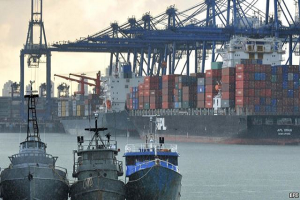
HAVANA, Cuba, 31 January 2014, www.cubanet.org – The position of the Port of Mariel has revalued the geographical importance of Cuba, lost with the end of the Cold War. The soldiers who for 46 years were the support of the government, when they began to direct everything in mid-2006 they found a country undercapitalized, productively and humanly.
General Raul Castro has moved the troops towards economic ends to confront the disaster that can not be overcome, despite his straitjacketed reforms that don’t encourage hard work and creativity to supply imports and increase exports.
As his travels through the friendly countries failed to achieve a financial injection for core investments and the replacement for the possible reduction or loss of petrodollars from Venezuela, he seems to have taken advantage of the changes in the 21st century, to preserve the fifty-year revolution, the “unity in diversity” of CELAC, beyond militant ALBA.
The transit of senior officers of the Armed Forces to create civilian businesses in innovative sectors began in the late 1980s and, especially, with the debacle of the “Special Period in Peacetime” and the loss of subsidies from the Soviet Union and other countries of real socialism.
In the early ’90s, Fidel Castro authorized the company Gaviota to engage in tourism, the TRDs or stores for the recovery of hard currency, and Raul Castro sought the implementation of the successful business system in the Revolutionary Armed Forces, but passing into the civilian sector without the conditions of organizational control military did not give the same results. From here much of the current entrepreneurs emerged.
The Port of Mariel is the only great monument built by the Revolution and will remain as a legacy of Raul Castro. Companies of the Ministry of the Armed Forces appear to have met the schedule and built a quality container terminal, inaugurated by the president and his Brazilian counterpart Dilma Rousseff last January 27.
Upon completion of all the works, perhaps it will join the seven wonders of Cuban engineering, like the Albear aqueduct, from the nineteenth century, still in use. Furthermore, the Special Development Zone boosts the national economy. A stark contrast to the legacy of destruction across the country, critically wrought over previous decades.
Undoubtedly, President Jose Inacio Lula da Silva and his successor, Mrs. Rousseff, calculated well the positioning in an economically asphyxiated Cuba. The Brazilians arrived in a big way to “help confront the northern neighbor,” to open American trade and tourism. The companies of the competitive Yankees advance with the best technology in the world.
Of course, it also entered the current priority calculations: Super Post-Panamax vessels, the Panama Canal expansion. In the Cuban press reports it was noted that the top leaders of the works are executives of the Brazilian company Odebrecht — the principal in the project — and Raul Castro said the administration of the container terminal will be in charge of one of the largest port operators in the world. Lamentable guarantee that inexperienced Cubans will not hard the adequate functioning.
As a prelude to the opening, the advantages of foreign investment in the Mariel Special Development Zone have been divulged. Russian, Chinese, German, British, French, Italian and Brazilian companies of course are mentioned as interested. The approach of the Mexican president could follow the same course. However, investors need guarantees that the old law doesn’t offer. Hence a new version has been promised.
As the project only benefits those who desire to hide their problems and arbitrariness, a greatly cultivated style in Cuba for decades, the presence of more European Union countries and the United States could be advantageous to the competence of the best economic opportunities, most advanced technologies, training, sources of jobs and less dependence.
Cubanet, 31 January 2014, Miriam Leiva
